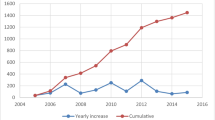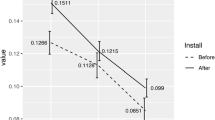Abstract
This article reports results obtained in an English national quasi-experimental multi-site evaluation of 14 closed-circuit television (CCTV) projects in residential areas, town and city centers, a city hospital, and car parks (parking lots). Both police and victimization data were collected before and after the installation of CCTV in target, control and buffer areas, and police Divisions. The results showed that CCTV was effective in reducing crimes in train station car parks but not in city centers or residential areas, seemed to be effective in reducing vehicle crimes (but not other types of crimes), and was most effective when the degree of coverage by CCTV was high and when CCTV was combined with other interventions such as improved lighting. Implications for situational crime prevention theory are drawn. There was no evidence of displacement or diffusion of benefits. It is concluded that CCTV needs to be implemented more effectively, based on an analysis of the crime problem and its causes, and needs to be evaluated using a randomized experimental design.
Similar content being viewed by others
Notes
Compared with the Home Office report, this article presents much more extensive meta-analyses, presents meta-analyses of survey data, compares target areas with buffer areas, presents more extensive analyses of displacement and diffusion of benefits, and deducts crimes in target, control and buffer areas from crimes in Divisions so that all numbers of crimes are mutually exclusive.
There was some evaluation of a 15th project, in a northern city center, but police data could not be collected for this project, and survey data were collected only for the target area, not for any comparison area. This project is excluded from the present article, as were two other projects that failed to be implemented within the period of the research. The names of all projects (with the exception of Hawkeye, which is unique) have been changed to protect their identity.
Monthly data were available for all Hawkeye car parks but not for the whole country.
Since RES is a ratio variable, natural logarithms of RES were correlated.
Effect sizes were based on police data except for Westcap Estate.
The term “odds ratio” was used by Welsh and Farrington (2002) because they viewed b/a and d/c as measuring the odds of crimes occurring after or before. However, because this is a non-standard use of the term “odds ratio”, the term “relative effect size” is used in this article.
Table 3 shows 36 areas with police data before and after, but the Division was the same for Market Town and Shire Town, leaving 35 different areas.
References
Armitage, R. (2002). To CCTV or not? A review of current research into the effectiveness of CCTV systems in reducing crime. London: National Association for the Care and Resettlement of Offenders.
Armitage, R., Smyth, G., & Pease, K. (1999). Burnley CCTV evaluation. In K. A. Painter & N. Tilley (Eds.), Surveillance of public space: CCTV, street lighting and crime prevention (pp. 225–249). Monsey, NY: Criminal Justice Press.
Blumstein, A., Cohen, J., Roth, J. A., & Visher, C. A. (Eds.) (1986). Criminal careers and “career criminals”, Vol. 1. Washington, DC: National Academy Press.
Clarke, R. V. (1997). Introduction. In R. V. Clarke (Ed.), Situational crime prevention: Successful case studies (2nd ed., pp. 1–43). Guilderland, NY: Harrow and Heston.
Cook, T. D., & Campbell, D. T. (1979). Quasi-experimentation: Design and analysis issues for field settings. Chicago, IL: Rand McNally.
Farrington, D. P., Bennett, T. H., & Welsh, B. C. (2007). The Cambridge evaluation of the effects of CCTV on crime. In G. Farrell, K. Bowers, S. Johnson, & M. Townsley (Eds.), Imagination for crime prevention: Essays in honor of Ken Pease. Monsey, NY: Criminal Justice Press.
Farrington, D. P., & Painter, K. A. (2003). How to evaluate the impact of CCTV on crime. Crime Prevention and Community Safety, 5, 7–16.
Farrington, D. P., & Petrosino, A. (2000). Systematic reviews of criminological interventions: The Campbell Collaboration Crime and Justice Group. International Annals of Criminology, 38,49–66.
Gill, M., & Spriggs, A. (2005). Assessing the impact of CCTV. London: Home Office (Research Study No. 292).
Gill, M., Spriggs, A., Allen, J., Hemming, M., Jessiman, P., Kara, D., et al. (2005). Control room operation: Findings from control room observations. London: Home Office (Online Report 14/05; http://www.homeoffice.gov.uk/rds/pdfs05/rdsolr1405.pdf).
Lipsey, M. W., & Wilson, D. B. (2001). Practical meta-analysis. Thousand Oaks, CA: Sage.
Painter, K. A., & Farrington, D. P. (1997). The crime reducing effect of improved street lighting. In R. V. Clarke (Ed.), Situational crime prevention: Successful case studies (2nd ed., pp. 209–226). Guilderland, NY: Harrow and Heston.
Piquero, A. R., Farrington, D. P., & Blumstein, A. (2003). The criminal career paradigm. In M. Tonry (Ed.), Crime and Justice (Vol. 30, pp. 359–506). Chicago: University of Chicago Press.
Sherman, L. W., Farrington, D. P., Welsh, B. C., & MacKenzie, D. L. (Eds.) (2006). Evidence-based crime prevention (revised ed.) London: Routledge.
Smith, M. J., Clarke, R. V., & Pease, K. (2002). Anticipatory benefits in crime prevention. In N. Tilley (Ed.), Analysis for crime prevention (pp. 71–88). Monsey, NY: Criminal Justice Press.
Weisburd, D., Wyckoff, L. A., Ready, J., Eck, J. E., Hinkle, J. C., & Gajewski, F. (2006). Does crime just move around the corner? A controlled study of spatial displacement and diffusion of crime control benefits. Criminology, 44, 549–591.
Welsh, B. C., & Farrington, D. P. (2002). Crime prevention effects of closed circuit television: A systematic review. London: Home Office (Research Study No. 252).
Welsh, B. C., & Farrington, D. P. (2004). Surveillance for crime prevention in public space: Results and policy choices in Britain and America. Criminology and Public Policy, 3, 497–525.
Welsh, B. C., & Farrington, D. P. (2006). Closed-circuit television surveillance. In B. C. Welsh & D. P. Farrington (Eds.), Preventing crime: What works for children, offenders, victims, and places (pp. 193–208). Dordrecht, Netherlands: Springer.
Acknowledgments
The authors are very grateful to the Home Office for supporting the National Evaluation, to Kate Painter for overseeing it, to Chris Kershaw for support and guidance, to Patricia Altham and Peter Grove for statistical advice, and to Darrick Jolliffe for statistical assistance. Angela Spriggs, Jenna Allen, Jane Bryan, Martin Hemming, Patricia Jessiman, Deena Kara, Jonathan Kilworth, Ross Little, Polly Smith and Daniel Swain worked on and made important contributions to the National Evaluation.
Author information
Authors and Affiliations
Corresponding author
Appendix
Appendix
Measuring effect sizes
In order to carry out a meta-analysis, there has to be a comparable measure of effect size in every evaluation. Welsh and Farrington (2002) found that the only comparable data that were reported in every CCTV evaluation was the number of crimes in time periods before and after the implementation of CCTV schemes. As far as possible, they analyzed the numbers of crimes in 12-month periods before and after:
| Before | After |
Experimental | a | b |
Control | c | d |
They used the odds ratio (OR) as the measure of effect size:
This measure is intuitively meaningful because it indicates the relative change in crimes in the control area compared with the experimental area. In this article, it is termed the “relative effect size” (RES).Footnote 7 RES = 2 indicates that d/c (control after/control before) is twice as great as b/a (experimental after/experimental before). This value could be obtained, for example, if crimes doubled in the control area and stayed constant in the experimental area, or if crimes decreased by half in the experimental area and stayed constant in the control area, or in numerous other ways.
The variance of the OR is usually calculated from its natural logarithm LOR:
In this article, we use LRES, the natural logarithm of RES, and refer to VAR (LRES). This calculation of VAR (LRES) is based on the assumption that crimes occur at random, according to a Poisson process. This assumption is plausible because 30 years of mathematical models of criminal careers have been dominated by the assumption that the commission of crimes can be accurately modeled by a Poisson process (Blumstein et al., 1986; Piquero et al., 2003). In a Poisson process, the variance of the number of crimes is the same as the number of crimes. Unfortunately, the distribution from one year to the next of the number of crimes in small areas is not known.
The problem is how to distinguish year-to-year changes in crime that are caused by CCTV from changes caused by numerous other influencing factors. In comparisons of only one small experimental area with one small control area, it is likely that other interventions (e.g., new policing strategies) and other influencing factors (e.g., the release of a prolific offender from prison) will impinge differentially on the experimental and control areas. These other factors will increase the variance of the number of crimes in an area and will make it more difficult to detect any effect of CCTV.
Our estimate of VAR (LRES) was based on the variance of the monthly number of crimes. The yearly variance was estimated as 12-times the monthly variance. If the yearly variances are denoted by Va, Vb, Vc and Vd:
In a Poisson process, Va = a (etc.), and this equation reduces to the usual one above. This estimate of VAR (LRES) is too high, because, unlike yearly figures, monthly numbers of crimes are influenced by seasonal factors. Hence, using this estimate means that the significance tests are conservative.
Excluding Hawkeye (where the number of crimes is based on 57 car parks), 70 sets of monthly crime figures were available for before and after periods in target, control and buffer areas and Divisions.Footnote 8 For each area in each year, the total number of crimes N was compared with V/N, where V is the estimated variance of the number of crimes (based on monthly numbers). In a Poisson process, V/N = 1.
It was clear that V/N increased with the total number of crimes. The correlation between V/N and N was 0.77 (P <0 .0001). A linear regression analysis showed that \( V \mathord{\left/ {\vphantom {V N}} \right. \kern-\nulldelimiterspace} N = .0008*N + 1.2 \)
This equation suggests that Poisson (random) variation is more important at small values of N, but that influencing factors become more important as N increases. For values of N up to 1000, V/N was between 1 and 2. Given the median value of N of 760, it might be expected that the median value of V/N would be 1.8, but in fact it was 2.3. The average value of V/N was 1.45 for the lowest ten numbers of crimes (average 105 crimes), 1.58 for the next ten (average 297), 1.97 for the next ten (average 485), 2.86 for the next ten (average 769), 4.56 for the next ten (average 2,650), 5.76 for the next ten (average 7,295) and 19.20 for the highest ten (average 24,327). Therefore, the Poisson assumption is most applicable for comparisons of small areas (target vs control or buffer), not for comparisons of target areas with Divisions.
Rights and permissions
About this article
Cite this article
Farrington, D.P., Gill, M., Waples, S.J. et al. The effects of closed-circuit television on crime: meta-analysis of an English national quasi-experimental multi-site evaluation. J Exp Criminol 3, 21–38 (2007). https://doi.org/10.1007/s11292-007-9024-2
Published:
Issue Date:
DOI: https://doi.org/10.1007/s11292-007-9024-2




